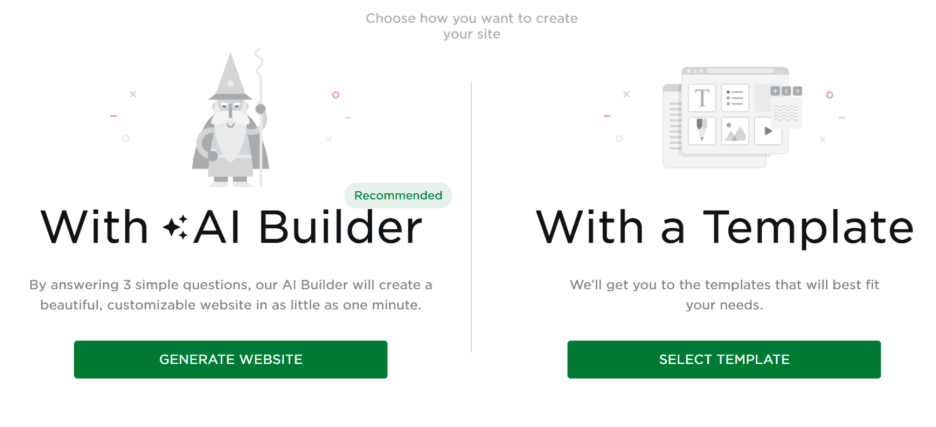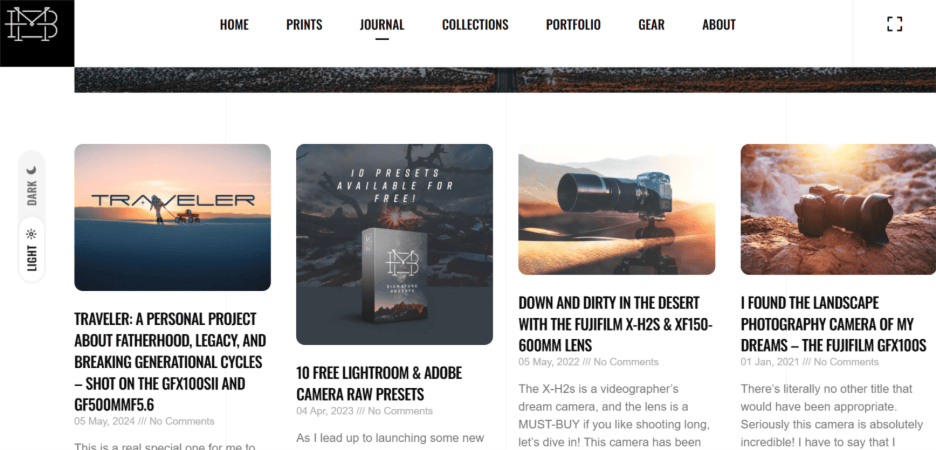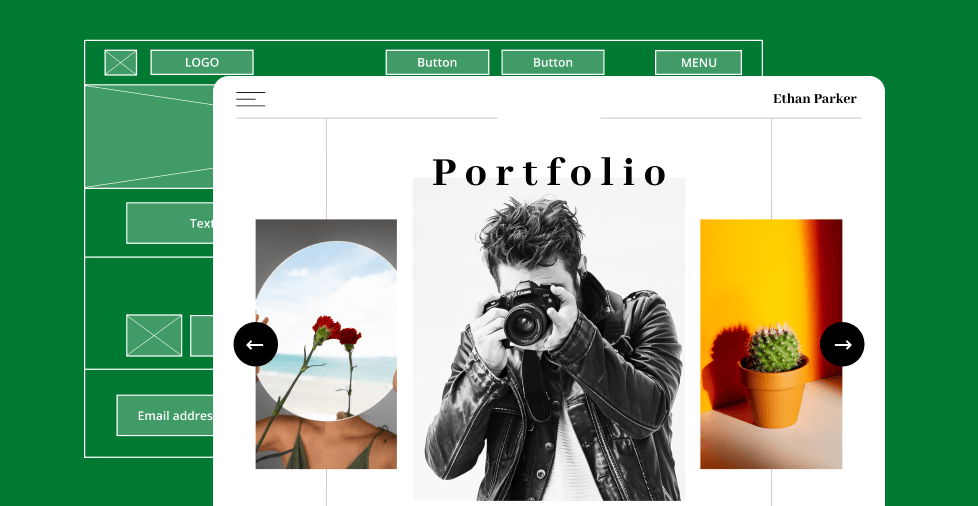Key takeaways:
- Having your own photography website gives you a permanent space to showcase your work and stand out from thousands of other photographers.
- Carefully planning your website’s structure, content, and design (including pages like Portfolio, About, Contact, and Pricing) helps clients understand your work and connect with you.
- Optimizing your site with SEO, testing it before launch, and promoting it through social media, newsletters, and testimonials ensures more people can find and trust your services.
The perfect shot isn’t enough to stand out in the photography industry. You’re competing against over 150,000 professional photographers in the U.S. alone. No matter what type of photography you do, you’ll surely be up against thousands of others trying to stand out too.
That’s why every outlet matters. Social media channels can help, but it’s fleeting, crowded, and simply not enough. The solution? Make your own photography website.
A photography website gives you something more permanent and shows clients you take your craft seriously. It also helps people get to know you better, understand your work, and see where you’re coming from.
In this guide, we’ll walk through how to build a photography website that not only highlights your best shots but also keeps your craft in focus.

How to build a photography website:10 easy steps
Ready to start building? Here are the steps you’ll need to create a stunning photography website:
- Define your photography website
- Secure your domain name
- Choose your web host
- Choose your website builder
- Plan your site structure
- Design and build your site
- Fill out your content
- Enhance for search engine optimization (SEO)
- Test before launching
- Promote your photography website
Let’s go through each step in detail in the following sections.
Step 1. Define your photography website
You’ll first need to define what you want your photography website to look like. Unlike other types of websites, a photography website is built on how you tell your client’s story, so you’ll need to keep this in mind.
To shape that image, here are a few questions to guide you:
- What type of photographer are you? Do you cover weddings and formal events? Do you focus on family portraits or nature photography? Or do you specialize in something else entirely?
- What do your previous clients value most about your photography? Is it a unique style, your editing approach, or the way you capture emotion?
- Who are the subjects of your photos?
- How might your clients’ needs change over time, and how can your site grow with them?
- What kinds of shots will your potential clients look for when visiting your site?
Your answers to these questions will help you define who your clients are, how your website should look, and what you want out of it.
Step 2. Secure your domain name
Your domain name is what you’ll promote to your clients. It’s how they’ll find you online. It often follows the format yourwebsite.com. The “yourwebsite” part of the domain is fully customizable, while the .com domain extension can be changed by choosing from a list of pre-set options.
Most photographers use their name, location, specialization, or a combination of these three as their domain name. It’s simple, promotes who they are, and highlights what they do. Here are a few examples:
- mrssmith.com
- denverportraits.com
- smithweddings.com
- familyphotos.com
- smithdenverweddings.com
If your desired .com domain is taken, you can use the .photography domain extension as a creative alternative. Better yet, explore other options with our AI domain name generator.

Step 3. Choose your web host
A web host is the service that powers your website online and keeps it accessible 24/7. It’s what determines how your site performs, so it’s important that your hosting services can match the needs of your visual content.
Since a photography portfolio website runs on high-resolution galleries, your hosting platform needs lots of storage and reliable bandwidth to load properly. So, while other sites can run on basic tiers and hosting types, it’s best for you to get a higher-tier package.
While it costs more, it also comes with added perks like an SSL certificate and domain name for the first year, and access to a website builder.
Our Essential plan can cover all these. It comes with both features and people to support you as your website expands.
Step 4. Choose your website builder
Your website builder determines how fast and how well you can customize your photography website. It’s important to choose a photography website builder that lets you:
- Easily insert images and text where you need them with drag-and-drop features
- Gives you the option to work with customizable themes and templates or an AI-powered website builder for fast and easy construction of your website
- Add eCommerce features so you can sell prints, packages, or stock photos.
- Connect to your calendar so can book client sessions online without back-and-forth emails.
- Allow social media integration so website visitors can easily connect with your Instagram, Facebook, and other Social pages.
- Include SEO and marketing tools to help your photography website reach a wider audience.

Pro tip: While you can get a website builder elsewhere, creating your photography website with the platform provided by your hosting provider makes it easier to get your site live.
Step 5. Plan your site structure
Before you start building your website, create a sitemap. This blueprint helps you plan the pages, features, and content your site needs, so nothing gets overlooked. It also maps out the journey visitors will take as they explore your site.
A sitemap is important for your site ranking too. Search engines often prioritize websites with sitemaps because it makes it easier and faster for crawlers to navigate your site.
To get started, begin by identifying the core pages you’ll need. Here are a few to focus on:
Home page
This is the first thing website visitors see when they land on your website, so think of it as your welcome mat. Use a strong hero image or slideshow to give them an instant feel for your style but don’t make it purely visual.
Your home page should also tell a story. A tagline or short statement that reflects your voice as a photographer can go a long way in connecting with visitors.
Navigation plays a big role here too. So, make sure your menu or hamburger icon is visible so visitors can easily move deeper into your site.
Pro tip: Go beyond the basics. Many photographers use their home page to showcase a featured gallery, highlight client testimonials, or even display a special offer. Here’s a great example from Jovana Rikalo’s photography website.

About page
This is where you tell your story. Share how you got into photography, any courses or classes you took, and what inspired you to start. This page is all about showing who you are beyond your photos. While your work speaks volumes, it’s your story that helps you connect with your audience.
Why is this important? Well, when you’re offering photography services, people want to work with someone they feel comfortable with. Your ‘About page’ is the perfect place to build that trust and ease any tension potential clients might feel.
Portfolio page
This is where you showcase your stunning photography. It can be tempting to upload as many images as you want, but it’s important to be selective. Only showcase your best work.
Organize your images into categories, aiming for 25-30 per gallery. This keeps your content impactful without overwhelming visitors, and it makes it easier for clients to explore. It also shows that each shot was taken with purpose.
Consider how you space out images within each gallery as well. Giving each photo room to breathe helps it tell its own story.
Pro tip: You don’t need to use the term “online portfolio.” In fact, many photographers use niche terms that are relevant to their work. For example, Rebecca x Lindsey’s Aboriginal art or something unique to your own style.

Contact page
This doesn’t have to be a page of its own, but it could be. What’s important is that you give your clients a means to contact you. It can be in the way of a contact for, or you could put your contact info on your home page.
It would be better to create a separate page though as this allows you to include a booking feature, places you service and other additional info clients need to know before contacting you.
Pricing Page
If you’re offering photography services, it’s important to be upfront about your rates. Transparent pricing helps you weed out clients who aren’t a good fit, while building trust and rapport with those who are.
To be transparent, state your starting rates and mention what’s included in each package. Detail the rates for everything, from the pre-shoot consultation to the delivery of the final product, so clients know exactly what they’re paying for.
Also, include any additional services you offer, such as albums, prints, or extra images. This gives clients the flexibility to tailor a package that fits both their needs and budget.
Blog page (optional)
A blog section is rare in photography websites, but it’s a huge, missed opportunity for better ranking. Search engines use written content to figure out how relevant your site is, and image labels just aren’t enough on their own.
Blogs also give your followers something to look forward to. With this page you can share behind-the-scenes stories, tutorials, and other personal experiences.
Bryan Minear’s journal section has wonderful examples of the kind of written content photographers can share.

Step 6. Design and build your photography website
Once you have a plan in place, it’s time to bring your photography website to life. Here’s how you can design your photography website:
- Map out the layout of each page. Use grids, boxes, and other design elements to plan where everything goes. This will help organize your pages and make filling in content faster and more efficient.
- Stay aligned with your brand vision. Look back at the definition and vision you created for your photography website. Choose colors and fonts or templates that reflect these. Identifying these elements early on will keep your design consistent and reinforce your brand identity.

- Incorporate interactive elements. Consider adding animation features like hover and fade effects to your photography portfolio. These subtle touches can bring your photographs to life and create a more dynamic user experience.
- Add functional properties. Add buttons, forms, and other interactive elements where appropriate. These features not only enhance the functionality of your site but also give users more reasons to explore your work.
Remember, while it’s fun to add lots of features to your site, you want visitors to fully explore your work rather than the site itself. So, make sure you design with this in mind.
Step 7. Fill out your content
Filling out the content of a fully designed photography website might seem easy, but there’s more to it than just dropping in images. You’ll need to adjust and prepare your photos and other content to ensure they don’t slow down your site’s performance.
Here are a few things to take note of when adding your content:
- Image format. Use JPEG for your photos. It’s universally supported by web browsers, so your image quality stays consistent. Keep them below a width of 2500px and a height of 1500px to ensure faster load times.
- Image resolution. When exporting images, select 72 dpi. This reduces the file size without compromising quality.
- Gallery and image labels. Use clear, location-specific descriptions for each image and gallery. This helps both clients and search engines understand where your photographs were taken, improving SEO.
- Logo format. Use PNG for your logo. This provides a transparent background, allowing you to place it anywhere on your site while it blends seamlessly with your design and photos.
If you’d like to take your photography website even further, consider adding behind-the-scenes shots or how-to tutorials. You could even offer these as subscription-only content, which allows you to earn money while positioning yourself as an expert in your craft.
Step 8. Enhance for search engine optimization (SEO)
Websites need to be optimized so they appear early in search results. It might seem complex at first, but the benefits are huge.
Try this: Search for “photography tips” on Google. You’ll see articles spread across multiple pages. Chances are, if you find what you need on the first page, you won’t even bother checking what’s on page 2. You definitely don’t want your website to be in that position.
To rank well, you’ll need to:
- Submit a sitemap
- Compress images
- Add alt text to every image
- Create clean page URLs
- Offer caching
- Ensure mobile responsiveness
- Add meta titles and meta descriptions
- Use keywords effectively
- Setup tracking
Submit a sitemap
The sitemap you created earlier is your key to better ranking. To get it working, you’ll need to submit your completed XML sitemap to both Google Search Console and Bing Webmaster Tools. Just be sure to submit an updated version whenever you make changes to your site.
Compress images
Use an image compressor to reduce the file size of your photos. This lightens the load on your web host and helps your site load faster.
Add alt text to every image
Search engine crawlers can’t “see” images, so alt text tells them what each image is about. It’s also helpful for users with visual impairments, so make sure your descriptions are as detailed and descriptive as possible.
Create clean page URLs
Clean URLs are especially important when using different pages for various galleries. They help with SEO by telling search engines what each page is about. Plus, they make your links easier for clients to read and click on from search results. For example, use /portraits instead of /page_id=3.
Offer caching
Caching stores your website data in visitors’ browsers, so when they return to your site, their device can load your pages faster.
Ensure mobile responsiveness
Around 95% of people access websites on their phones, so it’s important to check that your images and entire site are mobile-friendly. Even if a photograph fits on a mobile screen, there should be enough room for the rest of your site to be visible and easy to navigate.
Add meta titles and descriptions
Write unique meta titles and descriptions for each page. These are the snippets that appear in search results and can influence whether clients click on your link.
Use keywords effectively
Incorporate relevant keywords into your site’s copy, headings, and image alt tags. This helps search engines understand what your content is about.
Set up tracking
Install Google Analytics to track visitors’ behavior and Google search console to monitor your site’s performance in search results. This will tell you which pages your website visitors frequent, what do they click on the most and where do they linger. This will give you an idea of what works, what doesn’t and how to update your content.
Step 9. Test before launching
Before launching your website, do one final check to make sure everything is running smoothly. In fact, ask friends, family and even potential clients to help you out. A set of fresh eyes might be what you need to see where you can improve. To test your site, check.
- All links, buttons, and contact forms to make sure they’re working correctly.
- Your site’s navigation system. You might need to add, remove, or transfer your navigation tools depending on how fast and easy it is to move from one page to another.
- How your site appears across different devices. Make sure each image fits perfectly and still allow for smooth navigation.
- For any typos or errors. A final review from friends or clients can help catch mistakes you might have missed.
- Your social sharing image. This is the image that will appear when your site is shared on social media.
When you’re satisfied with how your photography website performs after testing, you’re ready to launch!
Step 10. Promote your photography website
You’re finally ready to go live. Congratulations! But you’re not done yet. It’s time to kickstart the buzz and keep the momentum going. To make sure your site is seen and always on people’s minds, you’ll need to promote whenever you can.
Here are a few ways you can promote your photography website:
- Share your work on social media. It’s the fastest way to let people know about your upcoming launch. If your pages are still new, keep posting too. Social platforms thrive on images and are one of the best ways to drive followers to your photography website.
- Build a newsletter. Encourage email signups by offering exclusive content or updates. This gives patrons a reason to visit your site regularly.
- Use Client Testimonials. Nothing builds more buzz than satisfied clients. Ask your customers for their feedback on your work and their experience. Just make sure to get their permission before you share their thoughts on your website.
- Start a blog. Few people expect a photography site to have one, which makes it a powerful way to stand out. Sharing stories, tips, and behind-the-scenes insights positions you as an expert and gives visitors more reasons to return.
- Network. Collaborate with influencers, past clients, or local businesses to cross-promote your work and reach new audiences.
- Offer special events. Run contests or limited-time deals like discounted sessions or prints. This is an effective way to drive bookings during your launch, around holidays, or as part of bundled packages.
Be cautious not to overspend on your website launch though. Photography websites are built on trust, credibility, and a strong portfolio — not a big splash.
Build a photography website that shares your vision
You now have everything you need to create a stunning website that reflects your style and attracts new clients. Every piece is in place to showcase your work.
All that’s left is to start building.
Unleash your vision with our customizable templates or AI-powered website builder. And if you’d rather leave it to the experts, our professional web design team can help bring your site to life.
When you’re ready, we’ll be proud to be part of your journey. Start building with Network Solutions today.
Frequently asked questions
The cost can vary widely, but a basic, professional website using a popular website builder typically costs anywhere from $100 to $400 per year. This includes your website builder subscription, a custom domain name, and hosting. The price increases with more advanced features, such as eCommerce capabilities.
Yes, you can. Some website builders offer a free plan, but they come with limitations. You typically can’t use a custom domain name, and the site will have ads. While a free site is a good way to start, it often isn’t seen as professional.
To sell prints on your website, you need an eCommerce plan or a website builder with e-commerce features. These plans provide the necessary tools for managing products, processing secure payments, and handling customer orders.
No, you do not need an LLC to start selling your photography. However, establishing one can help protect your personal assets and make it easier to manage your business finances.
To ensure optimal performance and a clean, cohesive portfolio, limit each gallery to 25-30 images. This keeps your site fast and allows visitors to focus on your best work without getting overwhelmed.




